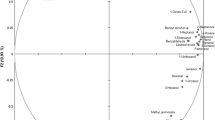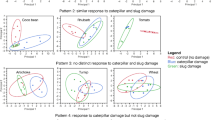Abstract
The volatile compounds emitted by leaves of 10 willow varieties that differ in their susceptibility to damage by blue (Phratora vulgatissima), brassy (P. vitellinae), and brown (Galerucella lineola) willow beetles were examined both before and after mechanical damage and correlated with feeding preferences of these beetles determined under laboratory conditions. Three compounds were identified from intact undamaged leaves of six willow varieties, namely cis-3-hexenyl acetate, cis-3-hexenol, and benzaldehyde. After mechanical damage, the yield and number of volatile compounds increased for all varieties. There were significant differences among willow varieties for both the concentration of cis-3-hexenyl acetate and the relative proportion of this compound to cis-3-hexenol (green leaf volatile ratio). The 10 varieties collectively showed a significant negative correlation between the relative resistance of each variety to blue and brown willow beetles and the yield of cis-3-hexenyl-acetate from damaged plants. The green leaf volatile ratio of damaged plants was also negatively correlated with the relative resistance of willow variety to these two beetle species.
Similar content being viewed by others
REFERENCES
BOLTER, C. J., DICKE, M., VAN LOON, J. J. A., VISSER, J. H., and POSTHUMUS, M. A. 1997. Attraction of Colorado potato beetle to herbivore-damaged plants during herbivory and after its termination. J. Chem. Ecol. 23:1003-1023.
COGHLAN, A. 2000. Double-crossed. A potato pest's favourite fragrance could be its undoing. New Sci. 165:14.
HARARI, A. R., BEN-YAKIR, D., and ROSEN, D. 1994. Mechanism of aggregation behaviour in Maladera matrida Argaman (Coleoptera: Scarabeidae). J. Chem. Ecol. 20:361-371.
HATANAKA, A. 1996. The fresh green odor emitted by plants. Food Rev. Int. 12:303-350.
KALBERER, N. M., TURLINGS, T. C. J., and RAHIER, M. 2001. Attraction of a leaf beetle (Oreina cacaliae) to damaged host plants. J. Chem. Ecol. 27:647-661.
KELLY, M. T. and CURRY, J. P. 1991. The influence of phenolic compounds on the suitability of three Salix species as hosts for the willow beetle Phratora vulgatissima. Entomol. Exp. Appl. 61:25-32.
KENDALL, D. A. and WILTSHIRE, C. W. 1996. An applied study of clonal resistance to willow beetle attack in SRC willows. Report for ETSU (DTI) Biofuels Study B/M4/00532/27/REP.
KENDALL, D. A., HUNTER, T., ARNOLD, G. M., LIGGITT, J., MORRIS, T., and WILTSHIER, C. W. 1996. Susceptibility of willow clones (Salix spp.) to herbivory by Phyllodecta vulgatissima (L.) and Galerucella lineola (Fab.) (Coleoptera, Chrysomelidae). Ann. Appl. Biol. 129:379-390.
LANDLOT, P. J., TUMLINSON, J. H., and ALBORN, D. H. 2000. Attraction of the Colorado potato beetle (Coleoptera: Chrsomelidae) to damaged and chemically induced potato plants. Environ. Entomol. 28:973-978.
LOUGHRIN, J. H., MANUKIAN, A., HEATH, R. R., TURLINGS, T. C. J., and TUMLINSON, J. H. 1994. Diurnal cycle of emission of induced volatile terpenoids by herbivore-injured cotton. Proc. Nat. Acad. Sci. USA 91:11836-11840.
LOUGHRIN, J. H., POTTER, D. A., and HAMILTON-KEMP, T. R. 1995. Volatile compounds induced by herbivory act as aggregation kairomones for the Japanese Beetle (Popillia japonica Newman). J. Chem. Ecol. 21:1457-1467.
LOUGHRIN, J. H., POTTER, D. A., HAMILTON-KEMP, T. R., and BYERS, M. E. 1996. Volatile compounds from crabapple (Malus spp.) cultivars differing in susceptibility to the Japanese beetle (Popillia japonica Newman). J. Chem. Ecol. 22:1295-1305.
LOUGHRIN, J. H., POTTER, D. A., HAMILTON-KEMP, T. R., and BYERS, M. E. 1997a. Response of Japanese beetles (Coleoptera: Scarabaeidae) to leaf volatiles of susceptible and resistant maple species. Environ. Entomol. 26:334-342.
LOUGHRIN, J. H., POTTER, D. A., HAMILTON-KEMP, T. R., and BYERS, M. E. 1997b. Diurnal emission of volatile compounds by Japanese Beetle-damaged grape leaves. Phytochemistry 45:919-923.
PASTEELS, J. M. and ROWELL-RAHIER, M. 1992. The chemical ecology of herbivory on willows. Proc. R. Soc. Edinburgh 98B:63-73.
PEACOCK, L. and HERRICK, S. 2000. Responses of the willow beetle Phratora vulgatissima to genetically and spatially diverse Salix spp. plantations. J. Appl. Ecol. 37:821-831.
PEACOCK, L., HERRICK, S., and BRAIN, P. 1999. Spatio-temporal dynamics of willow beetle (Phratora vulgatissima) in short-rotation coppice willows grown as monocultures or a genetically diverse mixture. Agric. For. Entomol. 1:287-296.
PEACOCK, L., LEWIS, M., and HERRICK, S. 2001. Factors influencing the aggregative response of the blue willow beetle. Entomol. Exp. Appl. 98:195-201.
ROJAS, J.C. 1999. Electrophysiological and behavioral responses of the cabbage moth to plant volatiles. J. Chem. Ecol. 25:1867-1883.
SCHüTZ, S., WEISSBECKER, B., KLEIN, A., and HUMMEL, H. E. 1997. Host plant selection of the Colorado Potato Beetle as influenced by damage induced volatiles of the potato plant. Naturwissenchaften 84:212-217.
TURLINGS, T. C. J., LENGWILER, U. B., BERNASCONI, M. L., and WECHSLER, D. 1998. Timing of induced volatile emissions in maize seedlings. Planta 207:146-152.
Author information
Authors and Affiliations
Rights and permissions
About this article
Cite this article
Peacock, L., Lewis, M. & Powers, S. Volatile Compounds from Salix spp. Varieties Differing in Susceptibility to Three Willow Beetle Species. J Chem Ecol 27, 1943–1951 (2001). https://doi.org/10.1023/A:1012278417424
Issue Date:
DOI: https://doi.org/10.1023/A:1012278417424




